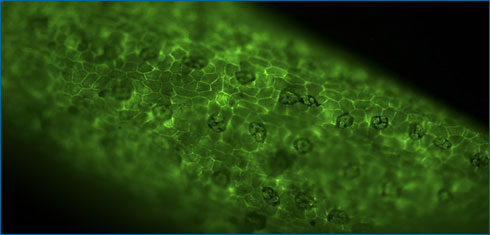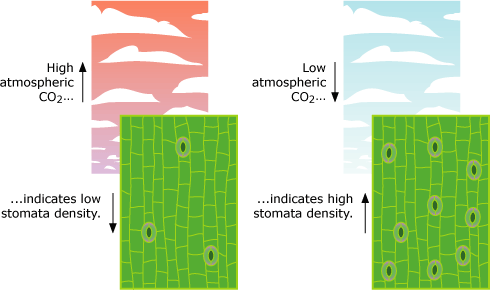Jennifer studies stomata that are preserved on the surfaces of fossil leaves. But what do stomata have to do with climate change? As an undergraduate in Ireland, Jennifer discovered that the number of stomata per square inch of leaf surface can reveal different aspects of the atmosphere in which that plant lived. Since then, she has continued in this vein of research. As Jennifer puts it, “Plants are wonderfully in tune with their environments, so there are many proxies or signals that we can obtain from fossil plants. We can work out the temperature they lived in, the atmospheric environment, and the carbon dioxide concentration.”

It works like this. Stomata control a tradeoff for the plant: they allow carbon dioxide in, but they also let precious water escape. A plant that could get enough carbon dioxide with fewer stomata would have an advantage since it would be better able to conserve its water. Levels of carbon dioxide in Earth’s atmosphere change over time — so at times when the atmosphere is carbon-dioxide-rich, plants can get away with having fewer stomata since each individual stoma will be able to bring in more carbon dioxide. During those high-carbon-dioxide times, plants that produce fewer stomata will have an advantage and will be common. On the other hand, when carbon dioxide levels are low, plants need many stomata in order to scrape together enough carbon dioxide to survive. During low-carbon-dioxide times, plants that produce more stomata will have an advantage and will be common.
Jennifer uses stomata as indicators of carbon dioxide levels at different points in Earth’s history. Experiments help her figure out the exact relationship between stomata and carbon dioxide. Using growth chambers, she can simulate the temperature, light level, and atmospheric conditions common at different times in the deep past and at different places on Earth. So even when it’s subzero in Chicago, her seedlings might feel as though they are growing in sunny California or in the humid swamps of the Jurassic. Studying how modern plants respond to these environments helps Jennifer understand how the characteristics of long extinct plants were affected by their environments.
Are the changes in stomata that Jennifer studies evolutionary changes? Read more in Nature or nurture: Evolution and phenotypic plasticity.
Get tips for using research profiles, like this one, with your students.

